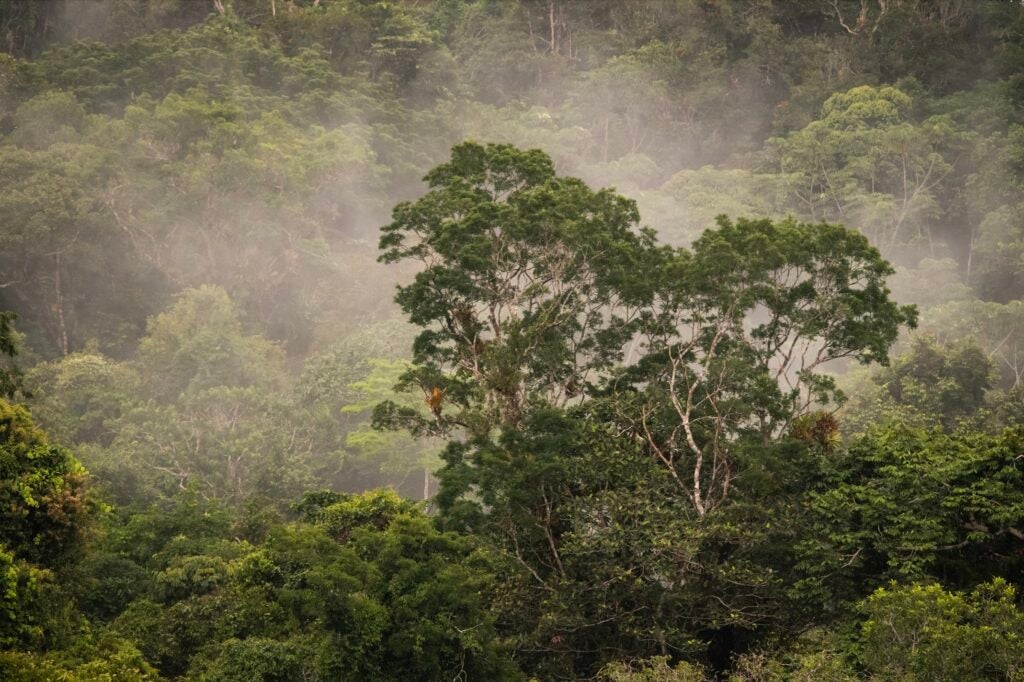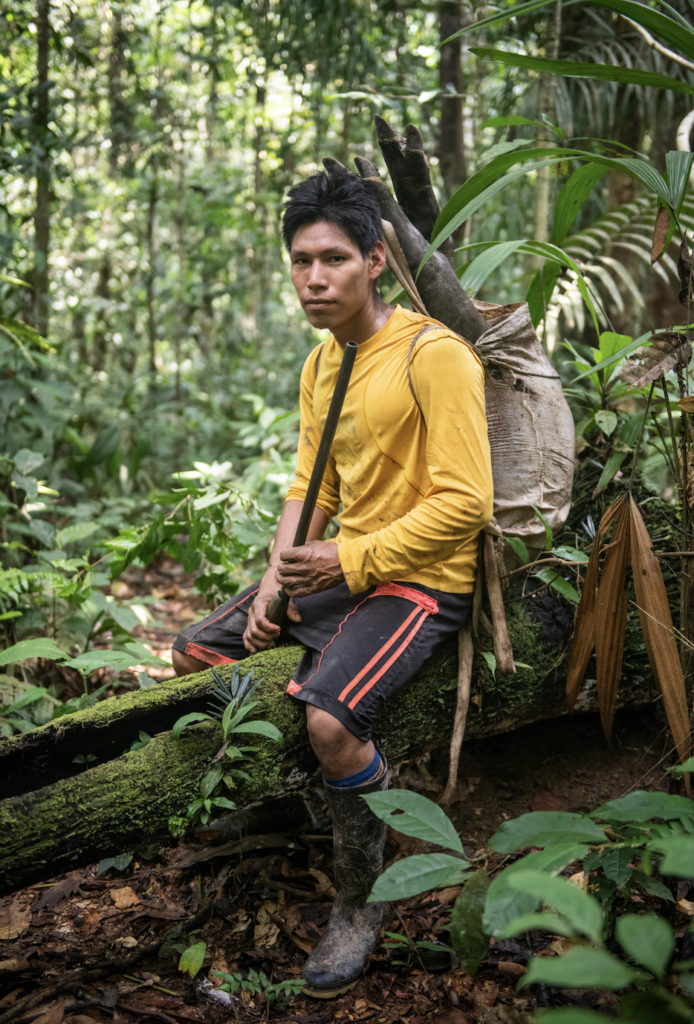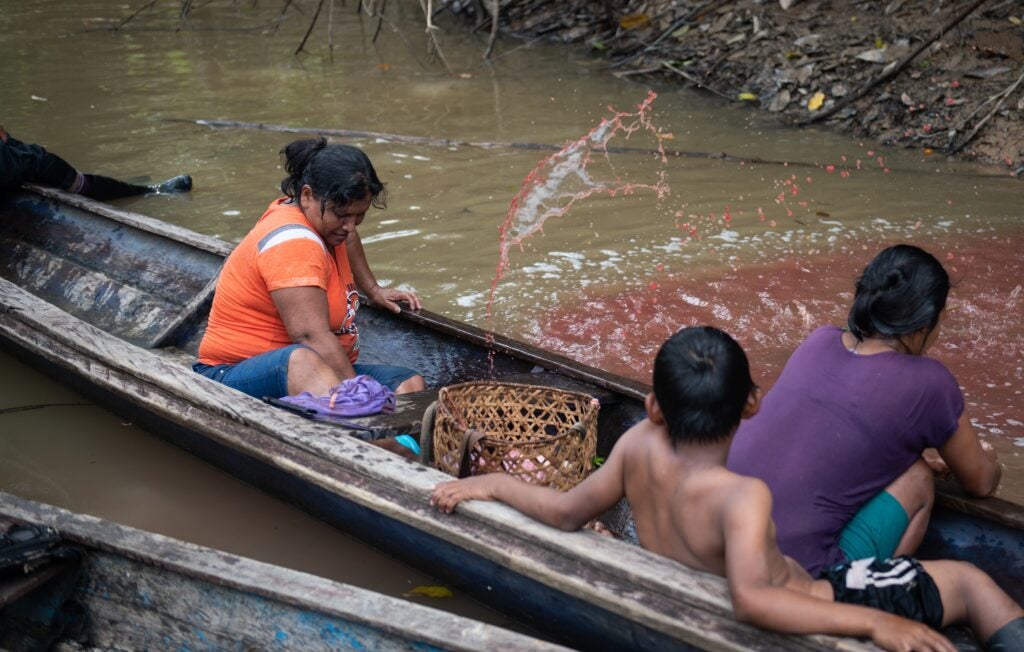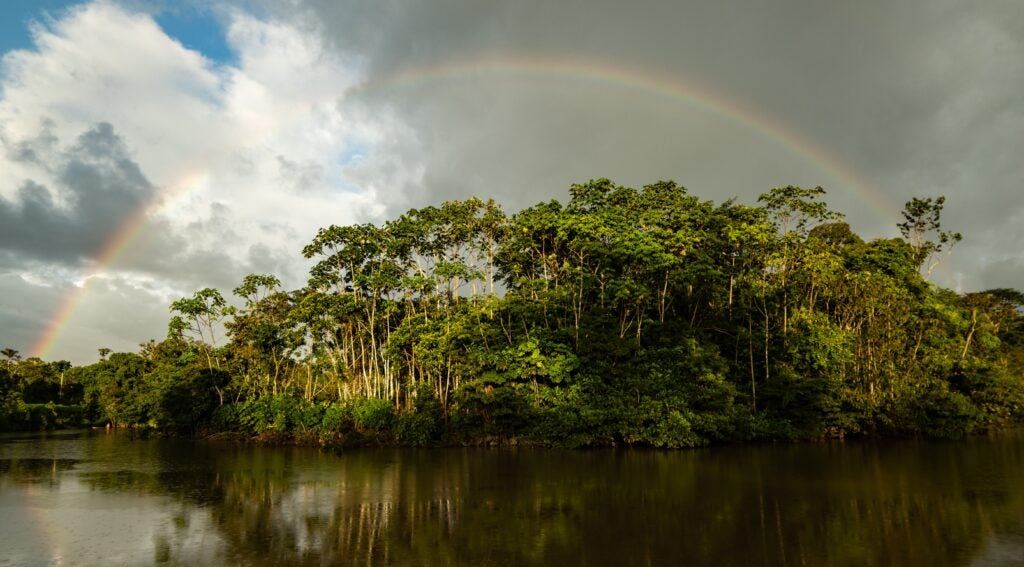Food, Culture, and Conservation in Maijuna Lands
By Brian M. Griffiths, Assistant Teaching Professor, The Earth Commons
This memoir is a creative account of Dr. Brian Griffiths’s research on mammal ecology and conservation conducted in collaboration with the Indigenous Maijuna people of Peru.

Trees among the mist in the Peruvian Amazon forest. Photo by Brian Griffiths.
I almost run into Jairo as he suddenly stops in front of me, hardly visible in the dense undergrowth, the steady one-foot-in-front-of-the-other rhythm of hiking making me daydream. He turns to me and whispers that we are nearing the lick, a prime hunting location. We continue quietly, and Jairo slips a cartridge into the shotgun that he has held slung over his shoulder all day. A half-hour more of creeping through the rainforest and swatting frantically at the pesky mosquitos is rewarded when we hear a noise ahead. Jairo takes off.
A boom echoes through the forest seconds later. Then, another one. I smell acrid smoke, which I follow into a small clearing ahead.
Jairo turns with a big smile on his face and embraces me in comradery. Peering over his shoulder, I see a muddy hole — definitively the mineral lick — and an equally muddy animal. Bright red streams of blood are visible in sharp contrast to the dull earthy background, and I realize that the animal is a lowland tapir. The herbivorous animal is a common visitor to mineral licks to supplement its diet. Surprised to see a tapir in real life, I stood there blinking for a few seconds before remembering why I had come. I unclip my GPS unit and notebook and grab the coordinates I need.
I turn to Jairo and congratulate him on his skill and success, but begin to wonder how we are going to get the 250-kg animal home. Tapirs are the largest animals in Maijuna lands—even bigger than jaguars—and have been given the fitting name of sachavacas, or “forest cows.” Tapirs perform ecosystem services that are critical to the rainforest that the Maijuna depend upon; they spread seeds from the fruits they consume as they walk, literally building up the forest structure itself. However, they have incredibly low reproductive rates and are unable to sustain a viable population under intense hunting pressure, making them a species of international conservation concern.

Portrait of Jairo, a Maijuna hunter, sitting on a log with a tapir in a bag on his back. Photo by Brian Griffiths
The Maijuna traditionally believe that tapirs and mineral licks are tied to their origins. In the traditional narrative, a Maijuna man named Békɨtù tries to trick his son-in-law, who has powers as a creator and subsequently turns Békɨtù into a tapir. He slowly takes on tapir-like qualities such as becoming skittish around people, eating palm fruits whole, and receding into the forest. He asks his daughter to bring him some masato, a traditional beverage of fermented yuca, but when she returns, Békɨtù will not go near her. His daughter becomes frustrated and throws the jar of masato on the ground. After she leaves, Békɨtù licks the masato from the ground, mixing it up with the soil with his hooves and creating the first mineral lick. Ónóbɨ, the Maijuna word for mineral lick, literally translates to “place of masato,” illustrating the Maijuna belief that animals visit the mineral licks to eat masato.
Many hours later, my ponderings are answered as we return to the mineral lick with a cadre of Maijuna community members in tow. They set to work, dragging the carcass out of the thigh-deep mineral lick mud and cleaning it. We set out on our long hike back with the sun waning and a considerably heavier load to carry.

Members of the Maijuna community in a boat during the tapir hunt. Photo by Brian Griffiths.
Tapirs are rarely hunted in Maijuna lands. Community norms prohibit the commercialization of their meat, making tapir a subsistence-only food whose consumption is tied to traditional culture. The preferred protein is the paca, a large rodent with a much higher population size and reproductive rate. Tapir populations in Maijuna lands are sustained by vast palm swamps that provide the animal’s favorite aguaje fruit, and the largest network of mineral licks ever discovered in an Amazonian watershed. However, when tapirs are hunted it is a community endeavor. A hunter typically calls neighbors and friends to help with the animal, and each person will leave with a sizable chunk of meat for their family. Sharing tapir meat, a critical protein in the remote region, builds social capital and contributes to food security. Now, if Jairo has an unsuccessful day hunting a few weeks from now, he may receive a chunk of meat or a few fish from one of these neighbors, ensuring that his family do not go hungry. These unwritten social norms ensure that all community members are cared for and fed.
As the sun sets, I scratch my chin and consider the foreleg of tapir sitting on the floor of my house, an incredibly kind gift from Jairo, who attributed his success to my good luck. I pick up my knife and set to work; I’ll gift some of this tapir leg since I cannot eat it all myself. After all, I “owe” my neighbor for a fish he left on my step for breakfast this morning.

Rainbow over a river and trees in the Peruvian Amazon forest. Photo by Brian Griffiths.
Want to read more about tapir behavior, game mammal conservation, mineral lick ecology, Maijuna traditional hunting practices, and the socioeconomics of game meat? Check out my recent research!
The Maijuna people are one of the most vulnerable Indigenous groups in Peru, with fewer than 600 individuals remaining in four communities. They safeguard an area of primary rainforest that’s almost a million acres (that’s 22 percent larger than Yosemite National Park!) which makes up the Maijuna-Kichwa Regional Conservation Area (MKRCA) and a large portion of their ancestral lands. The Maijuna can legally hunt in the MKRCA, and the enormous area ensures that hunting is sustainable. The Maijuna are longtime partners in my community-based research. One of the stated priorities of the Maijuna Federation is to conserve their local mammal populations and understand how hunting impacts those mammals. I support this stated objective with my research.
Mammal conservation work in Maijuna lands is a collaborative effort between the Maijuna and NGOs OnePlanet and the ACEER Foundation, and others.
